KINDS AND EFFECTS OF DEFECTIVE COLOR VISION
These are the major types of color vision defects:
- Protanopia - The loss of the red-sensitive cells
A person with protanopia sees in tints and shades of the colors yellow and blue. Red objects look very dark.
- Deuteranopia - The loss of the green-sensitive cells
A person with deuteranopia sees in tints and shades of the colors yellow and blue. Green objects are slightly darker than normal.
- Tritanopia - The loss of the blue-sensitive cells
A person with tritanopia sees in tints and shades of the colors red and green. Blue objects look dark.
- Tetartanopia - Undocumented loss of sensitivity to yellow (see inset)
- Protanomaly - The red sensitive cells are sensitive to leaf green (yellow green) instead of
red
A person with protanomaly sees full color, but some oranges, yellows, greens, and browns are seen as the wrong color.
- Deuteranomaly - The green sensitive cells are sensitive to yellow instead
A person with deuteranomaly sees full color, but some oranges, yellows, greens, and browns are seen as the wrong color.
- Tritanomaly - The blue sensitive cells are sensitive to cyan instead
A person with tritanomaly sees full color, but some magentas, violets, blues, cyans, and greens are seen as the wrong color.
- Red-Green Indistinction - No red-green differentiation but no sensitivity changes
A person with red-green indistinction sees in tints and shades of yellow and blue. All objects are the correct brightness (no change in spectral sensitivity). Causes include missing bipolar cells differentiating red and green, or red and green pigments mixed in the same kind of cone cell.
- Red-Green anomaly - Both the red sensitive cells and the green sensitive cells respond to the
wrong colors.
A person with red-green anomaly sees color, but some reds, oranges, yellows, greens, and browns are seen as the wrong color.
Red-green anomaly is protanomaly and deuteranomaly in the same person.
- Cone Monochromatism - Only the blue sensitive cells and the rods work
A person with cone monochromatism sees the world in black and white. Green and yellow appear dark, and red appears black.
- Rod monochromatism - Only the rods work
A person with rod monochromatism sees the world in black and white. Reds appear black. The person can not see well in bright light.
For more on this, see Human Color Vision Defects.

DEFECTIVE COLOR VISION
Outer ring:
Normal color vision
Second ring:
Protanopia
Third ring:
Deuteranopia
Inner ring:
Tritanopia
More Definitions
- Protan - Refers to any defect in the red cone, including protanopia and protanomaly
- Deutan - Refers to any defect in the green cone, including deuteranopia and deuteranomaly.
- Tritan - Refers to any defect in the blue cone, including tritanopia and tritanomaly.
Tetartanopia is very rare, if it exists at all. It might be a failure of the bipolar cells for blue-yellow differentiation. Or it might have been an attempt to provide a missing disease that the Hering Opponent Color theory predicted.
AN AID THE DRIVER CAN USE FOR ANOMALOUS TRICHROMATIC VISION
For people with anomalous trichromatic vision (protanomaly, deuteranomaly, or tritanomaly), a special solution now exists. It is a set of glasses with notch filters that remove spectral yellow and spectral cyan from the light entering the eye. The remaining light usually has the necessary information for correctly identifying most colors, but without interference from the anomaly.
A company named EnChroma makes these glasses.
Traffic signals and signs should appear the correct color to anyone with anomalous trichromatic vision wearing these glasses.
Note that these glasses do not work for dichromatic vision (protanopia, deuteranopia, tritanopia, or red-green indistinction) or monochromatic vision (single cone type or cone blindness).
One caveat is that the light from a low-pressure sodium streetlight (monochromatic yellow) is rendered totally invisible by these glasses. If this happens, the glasses must be removed while the driver is driving under low-pressure sodium streetlights.
DESIGNING TRAFFIC SIGNALS TO COMPENSATE FOR DEFECTIVE COLOR VISION
Because recognizing the aspect of the traffic signal is so important to traffic safety, special engineering is needed to ensure that drivers with defective color vision receive the correct message. Several methods are used:
- Position of the lamp in the signal face.
- Selection of colors that can still be distinguished from each other by most people with defective color vision.
- Other methods, such as different shapes for different colors.
Positioning the lamps in the signal face:
The US Department of Transportation sets requirements in its Manual on Uniform Traffic Control Devices (MUTCD). The following are requirements for positioning of lamps within the signal face, intended to aid people with defective color vision to determine the correct signal aspect:
- Each signal face must have 3, 4, or 5 lamps.
- All red lamps must be above all other lamps in vertical faces and cluster faces.
- All red lamps must be to the left of all other lamps in horizontal faces.
- In vertical and cluster faces, each yellow lamp must be directly above its corresponding green lamp.
- In horizontal faces, each yellow arrow must be directly to the left of its green arrow.
- A flashing yellow arrow for permissive turns must be between the yellow arrow and the green arrow.
- Green indications never flash.
Color of the signal lamps:
The US Department of Transportation also sets requirements for the colors of traffic signal indications. The following are the specification for the colors of signal indications:
The red signal must give off some orange light, but no green or blue light.
The yellow signal must give off some orange and green light, but no blue light.
The green signal must give off some blue light, but no yellow or red light.
The orange pedestrian signal must give off some red and yellow light, but no blue light.
The white pedestrian signal must give off more blue than orange.
With Light Emitting Diode (LED) signals, these colors have finally been produced. In the days of incandescent lamps, this standard was easier stated than achieved. The signals, especially the green ones, gave off colors they were not supposed to. But the technology was not there to produce the correct colors. These were the best colors available:
The red leaks yellow and white.
The yellow leaks white.
The green leaks white.
The following table shows how each signal lamp looks to people with the most common color defects:
| Signal color | Protanopia | Deuteranopia | Tritanopia | Red-Green Indistinction | Monochromatism |
|---|---|---|---|---|---|
The signal colors are usually easily distinguished.
The shapes on the pedestrian signals remove the need for color identification.
|
Two problems remain:
|
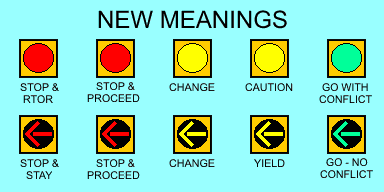
The 10 Standard Indications
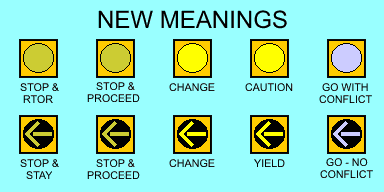
As Seen With Deuteranopia |
Other Methods:
|
The MUTCD does not allow most of these other methods:
|

Canada Shapes Signal

Korean Signal

Canada Double Red Signal
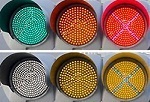
Japanese Signal
|
A NEW SOLUTION
The new solution combines the Japanese magenta X in the red signal (above) with a modification of the red arrow:
- The circular red signal has a magenta X in it. It is seen as a totally different color by people with protanopia or deuteranopia.
- The stem of the red arrow is also magenta, making it appear a different color than the color of the barbs.
- The other signals are the standard colors prescribed in the MUTCD.
Examine the diagrams below. Note that the signals are easily recognized in all cases:
- In the case of protanopia, the red signals are much more visible, because the X and the arrow stem stand out against the dimmer remainder of the lighted portion.
- In the case of deuteranopia, the red signals are two different colors, with the X and the arrow stem looking blue, while the rest of the lighted portion appears yellow.
- In the case of tritanopia, the X and the stem of the arrow are not seen as different from the rest of the red signal. But it does not matter, because the three signal colors are quite distinctly different in tritanopia.
- All of the signals are distinctly different colors in all cases of anomalous color vision.
- The red signal is even distinctly different for people with monochromatism, because the X and the stem of the arrow are brighter than the rest of the lighted portion. Look at the diagram for protanopia to get the idea.
- The person with normal vision barely notices the change in color in the red signal.
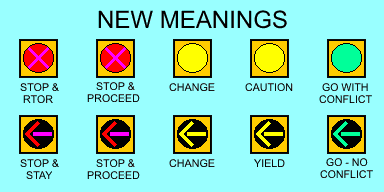
Colorblind Signal, Normal Vision
|
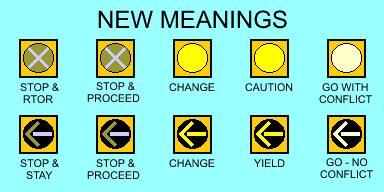
As Seen With Protanopia
|
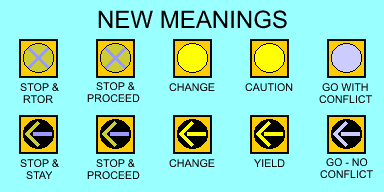
As Seen With Deuteranopia
|
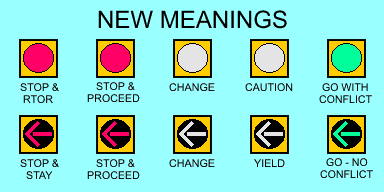
As Seen With Tritanopia
|
The diagrams here are derived from a diagram originally used on one of the page author's other web pages. The text in the diagrams pertains to material on the other page.